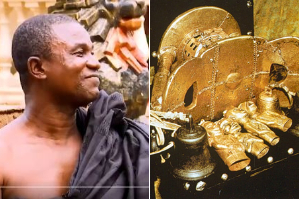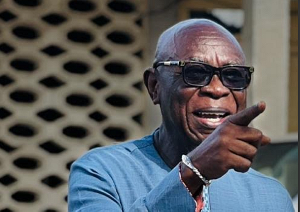The Curator at the Manhyia Palace Museum, Justice Brobbey, has drawn similarities between the Ark of the Covenant in biblical days with the Golden Stool of the Ashantis.
According to him, the sacredness of the stool, which he said he prefers to call the Gold Stool, instead of the golden stool, is such that it is like the blood and soul of the Asante people.
He explained further that the stool is so sacred, it is not one that must be seen or touch by just anybody and it is the reason its location is not even known to just anybody.
Justice Brobbey was responding to questions by a presenter on Toast on GHOne TV during an interview with him at the Manhyia Palace in Kumasi recently.
“The Golden Stool is still with us… why do you have to see it?... I prefer to call it the Gold Stool instead of the Golden Stool. It’s not everything golden that is gold; golden is not gold. We have gold watch and that’s the same way we have gold stool.
“So, ours is gold, because Asante is rich in gold, we sit on gold, we eat gold, everything is gold, so everything is gold and it’s supposed to come out every five years. You know, every year, we have about 8-9 festivals that we celebrate. The last one is when the Gold Stool comes out, that is the Adaekese, where all the paramount chiefs will join the Asantehene in Kumasi and celebrate Adaekese, but now, it is the prerogative of the king to decide when it will come out and it is every five years, or when Asante is celebrating a milestone, that is when the gold stool comes out… that we don’t encourage people – you and I, to touch it, to see it. Some people have gold in their home, but this one is their blood, it is their god.”
He continued to say that, “You remember in the Old Testament in the Bible, they had this the Ark of the Covenant, so any time the Israelites went to war and the war became tough, they took it along. And it’s the same way and at the (sic) of the gold stool, you saw what happened. So, at the same way in Asante, the Gold Stool is like our everything; very powerful that we don’t play or do bad things to it. It comes out at the time it is supposed to come out.”
About the Golden Stool
The Golden Stool (full title, Sika Dwa Kofi) has been the symbol of power in Ashanti Kingdom since the 17th century. According to oral tradition, Okomfo Anokye, a High Priest and one of the two founders of the Ashanti Confederacy, conjured the Golden Stool, decorated with golden bells, and caused it to descend from the sky where it landed at the feet of Osei Tutu I, the first Asantehene (King) of Ashanti. Beginning with Osei Tutu I, the Ashanti have believed that the Golden Stool houses the soul of the Ashanti nation.
The Stool, made of gold, stands 18 inches high, 24 inches long, and 12 inches wide. It was never allowed to touch the ground and was considered so sacred that no one was allowed to sit on it. Each new Ashante king is lowered and raised over the Golden Stool without touching it. No one could be considered a legitimate ruler without the Golden Stool, which usually occupied its own throne next to the Asantehene.
The Ashanti maintained the Golden Stool as their most prized possession. Before they went to war, their war chiefs consulted it. As time progressed and as the Ashanti scored more victories over their rivals, turning their kingdom into an empire, the Golden Stool became even more revered.
By the 19th Century, the Ashanti began a series of clashes with the British Empire which had established effective control of the coastal region of what is now Ghana. They fought three Anglo-Ashanti Wars between 1824 and 1874, with the British and their African allies gaining more control over Ashanti Territory. During the fourth Anglo-Ashanti War, the British and their Indian and African allies defeated Asantehene Agyeman Prempeh, eventually capturing him and sending him into exile in the Seychelles Islands.
The final war (1900), essentially a rebellion led by Yaa Asantewaa, the Queen Mother and Gate Keeper of the Golden Stool, was prompted by the demand by Sir Frederick Mitchell Hodgson, the British Governor of the Gold Coast to sit on the Golden Stool. With his remark, Yaa Asantewaa led a rebellion called the Word of the Golden Stool which began on March 28, 1900. The intense fighting led to the death of more than 2,000 Ashanti and 1,000 British and Allied troops. Both totals were higher than the deaths from all previous Anglo-Ashanti wars combined. The war ended, however, after six months.
Yaa Asantewaa was captured by the British in 1901 and quickly exiled to the Seychelles, where she died in 1921, but the British never captured the Golden Stool. Hidden by the Ashanti, it was discovered by a group of African railroad builders in 1920. They stripped it of its gold ornaments and were tried by the Ashanti and sentenced to death. British colonial authorities intervened, however, and they were exiled from the Gold Coast Colony.
After realizing the importance of the Golden Stool to the Ashanti, the British gave assurances that they would never interfere with it again. Restored to its ceremonial place, the Golden Stool continues to be used in rituals crowning the Asantehene, although he is now considered a traditional ruler without political power or influence. Nonetheless, the Golden Stool remains a cherished symbol of the former Ashanti Empire.
AE
General News of Saturday, 26 October 2024
Source: www.ghanaweb.com
The similarities between the Ashanti Golden Stool and the biblical Ark of the Covenant
Entertainment
















